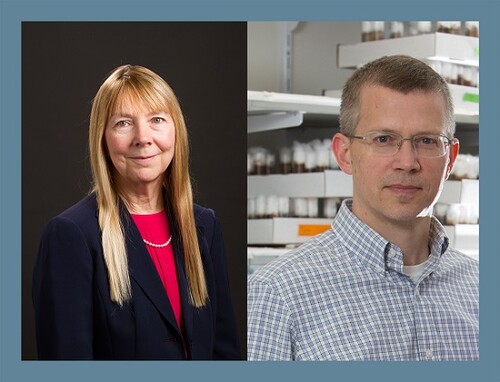
MB&B professors Dr. Karen Anderson and Dr. Anthony Koleske published a paper this month in the Journal of Biological Chemistry called ‘Platelet-derived growth factor receptor beta activates Abl2 via direct binding and phosphorylation.’ The Abl family kinases are nonreceptor tyrosine kinases which regular a variety of cellular activities such as cytoskeleton organization and adhesion. Abl family kinases are closely regulated by post-translational modifications and a variety of complex intra- and intermolecular interactions. One player in the regulation of Abl family kinases is the platelet-derived growth factor receptor beta (PDGFRβ) which is vital for cell proliferation and chemotaxis, but the molecular mechanism in which PDGFRβ engages in to activate Abl family kinases was previously unknown.
Dr. Anderson and Dr. Koleske describe the interactions between PDGFRβ and Abl2, a specific Abl family kinase found in vertebrates. Non-activated Abl2 are kept inactive through an autoinhibitory mechanism involving intramolecular interactions with the Src homology 3 (SH3) and Src homology 2 (SH2) domains, but it has been proposed that interactions with cellular binding partners relieve the inhibition. In their new publication, the Anderson and Koleske labs show that PDGFRβ binds Abl2 and phosphorylates multiple novel sites including areas at or near the SH3 and SH2-kinase linker interface– the region implicated in autoinhibition. After establishing the sites phosphorylated by PDGFRβ, they show in vitro that the PDGFRβ-mediated phosphorylation activates the Abl2 kinase activity. They then mutate the phosphorylation sites from tyrosines (one of the most common amino acids to be phosphorylated) to phenylalanine in order to prevent these phosphorylation events. This experiment revealed that mutations of four specific tyrosines in Abl2 (Y116, Y161, Y272, and Y310) compromise the PDGFRβ-mediated activation of Abl2 which suggests these sites are crucial for proper Abl2 activation.
This study gives insight into the interactions between PDGFRβ and Abl2 in the context of Abl2 regulation, and also provide a framework to better understand how growth factor receptors can engage with and regulate Abl family kinases through multistep phosphorylation events.
Read the full paper here.
By Jake Thrasher